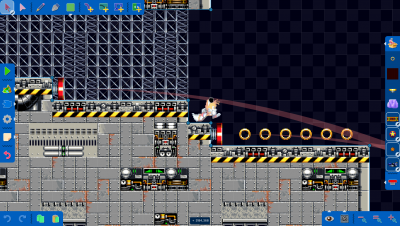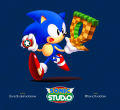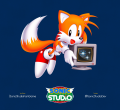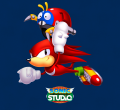Sonic Studio
From Sonic Retro
| Sonic Studio |
|---|
| Engine: GameMaker[1][2] |
| Credits: Lapper[2] |
| Development status: Active |
| Operating system: Windows PC |
- For the Sega division which manages the Sonic franchise, see Sonic Studio (company).
Sonic Studio, also known as Sonic the Hedgehog Studio[3][4], is an in-development fan Sonic the Hedgehog stage creation program for Windows PCs.[2] Developed and produced by independent British artist and Sonic scene member Lapper, it allows users to create entirely custom Sonic stages with intuitive menu design, extensive customization features, and a focus on ease of use.
As of March 2023, Sonic Studio is still being actively developed, with the entirety of the game's planning already finalized.[1][2]
Contents
Features
Sonic Studio's stage creator is designed to be as authentic to the classic Sonic the Hedgehog games as possible while still allowing for extensive player creativity. Users can create polygon-based terrain shapes and place water, enemies, bosses, items, hazards, and more, all with a simple point-and-click interface (including the auto-generation of a variety of loop shapes). Each stage's time of day can also be changed, as can the time limit and available characters. Sonic Studio also features a number of decoration and customization options, including the ability to auto-generate decorations throughout the created stage (such as flowers and totem poles).[2] Created stages can be saved, loaded, and played at any time, all within the editor.
One of Sonic Studio most unique features is its versatile interaction system. Objects and enemies can directly interact with each other, with a proposed example being a gauntlet of enemies bouncing on springs which Tails must navigate while flying[5], or stacking large number of boxes for potential stage puzzles.[6] Buttons can be placed and linked to specific actions, allowing a depth of behind-the-scenes machinery for possible creative use. More traditional stage interactions can also be placed, such as spindashing through breakable walls.[6]
Uniquely, the game's framework uses vectors and line intersections to perform its collision checks, and builds terrain as entirely custom polygonal shapes, meaning any shape whatsoever is possible to build.[6] Character physics have been significantly improved from the original Mega Drive games, including the notable elimination of camera jittering visible during loops, and with Lapper taking extra steps to ensure any shape of terrain will be traversed smoothly (like performing extra checks while on slopes).[7]
A total of 11 zones have been planned for the final release, with at least one zone from every classic Sonic game (1, 2, CD, 3, S&K) represented.[8] Playable characters include Sonic, Tails, and Knuckles, who can be used with either a keyboard or controller.[8] The game also boasts redrawn pixel artwork for character, items, enemies, and stage graphics (courtesy of Lapper himself), as well as remixed music from artists Jahn Davis and Noah Copeland.[2] Importantly, Sonic Studio is currently being developed with a focus on single player stage creation and sharing, and while it will not be initially released with a story mode, Lapper stated he hasn't ruled out the possibility of adding such a mode in the future.[8]
At this point in development, stages are able to be shared, but must be done so by manually copying a long string of text. Lapper has stated that he wishes to see a proper built-in online sharing hub[6], and reportedly the game has already been programmed to support this feature.[8] At the moment however, focus must be paid to developing the actual engine and gameplay, and Lapper clarifies that such a feature would require the assistance of a second programmer. His plan is to have Sonic Studio launch with an intuitive sharing hub, but adds there may be an initial release which lacks it.[8]
Zones
Enemies
Production credits
- Artist & Developer: Lapper[1][9]
- Musicians: Jahn Davis[1][9], Noah Copeland[1][9]
- UI Design: Mr. Chao[1]
- Special Thanks: Mercury[1]
History
Development
| “ | The idea for a fangame Sonic stage editor took initial form, at least for me, with the creation of 'Sonic Maker' in 2009. It was inspired by the PlaySega Sonic level creator. I was, unfortunately, unable to give Sonic Level Creator a try, so I gathered what little I knew of programming at the time and took it into my own hands. 'Sonic Maker' included a rudimentary stage editor created in Visual Basic, and used an old GM8 Sonic framework separate from the editor to play stages. Fast forward to 2017, Mania released and inspired me to try again. | „ |
| — Lapper[1] | ||

Upon the release of PlaySEGA's official Sonic the Hedgehog Level Creator, Sonic scene member Lapper found himself unable to access the online editor, and was inspired to program a level creator of his own.[2] From this desire came 2009's Sonic Maker, one of the first Sonic fangames which allowed users to design their own levels. Later, the release of 2017's Sonic Mania further inspired Lapper to return to the idea of a level creation program.[2]
Early development on Sonic Studio began in 2017, and according to Lapper, "became a full on project in 2018".[10] Lapper has clarified that Sonic Studio is being developed less as a strict software tool and more as a "sandbox plaything" emphasizing player creativity.[6] He recalls his inspiration for the game's art design being "a mix of Sonic Mania, Tyson Hesse and a slight flair of my own"[6], with Sonic's sprite being based off his appearance in the first two Mega Drive titles. Sonic Studio's current logo is inspired from early development fan art by artist Team Sora.[11]
Prerelease
Sonic Studio was first announced in May 2018[2] and was initially known under the working title Sonic Maker[12] (a reference to the developer's previous level creator of the same name). The professionalism and accessibility of the project eventually caught the eye of the gaming public, with most responses being unanimously positive - frequently praising the game's friendly interface, and drawing similarities with Nintendo's Super Mario Maker. The game even captured the attention of Yuji Naka, who retweeted an official Sonic Studio video in amazement and began following the project.[13]
Lapper continues to share updates on the project's development through both Sonic Studio's official website and forum thread.[14]
Interviews
Screenshots
Prerelease
Artwork
External links
- Official website
- Official thread at Sonic and Sega Retro Forums
- Sonic Studio at Twitter
- Retro Spotlight - Sonic Studio article by Neo Hazard at Sonic Retro
References
- ↑ 1.0 1.1 1.2 1.3 1.4 1.5 1.6 1.7 https://sonicstudiofangame.weebly.com/information.html (Wayback Machine: 2023-03-02 23:09)
- ↑ 2.0 2.1 2.2 2.3 2.4 2.5 2.6 2.7 2.8 https://forums.sonicretro.org/index.php?threads/sonic-studio.38013/
- ↑ https://www.youtube.com/watch?v=LyY_jyu_8G4
- ↑ File:SonicStudio logo.png
- ↑ @SonicStudioProj on Twitter
- ↑ 6.0 6.1 6.2 6.3 6.4 6.5 Interview: Lapper (2019-08-15) by Sonic Stadium
- ↑ https://sonicstudiofangame.weebly.com/blog/improving-classic-sonic-physics (Wayback Machine: 2023-04-08 23:51)
- ↑ 8.0 8.1 8.2 8.3 8.4 https://sonicstudiofangame.weebly.com/faq.html (Wayback Machine: 2023-03-07 04:16)
- ↑ 9.0 9.1 9.2 @SonicStudioProj on Twitter
- ↑ https://sonicstudiofangame.weebly.com/faq.html (Wayback Machine: 2023-03-09 10:06)
- ↑ @Sora_Kishino on Twitter
- ↑ File:SonicStudio logo early 1.jpeg
- ↑ https://forums.sonicretro.org/index.php?threads/sonic-studio.38013/page-12#post-993794
- ↑ https://sonicstudiofangame.weebly.com















